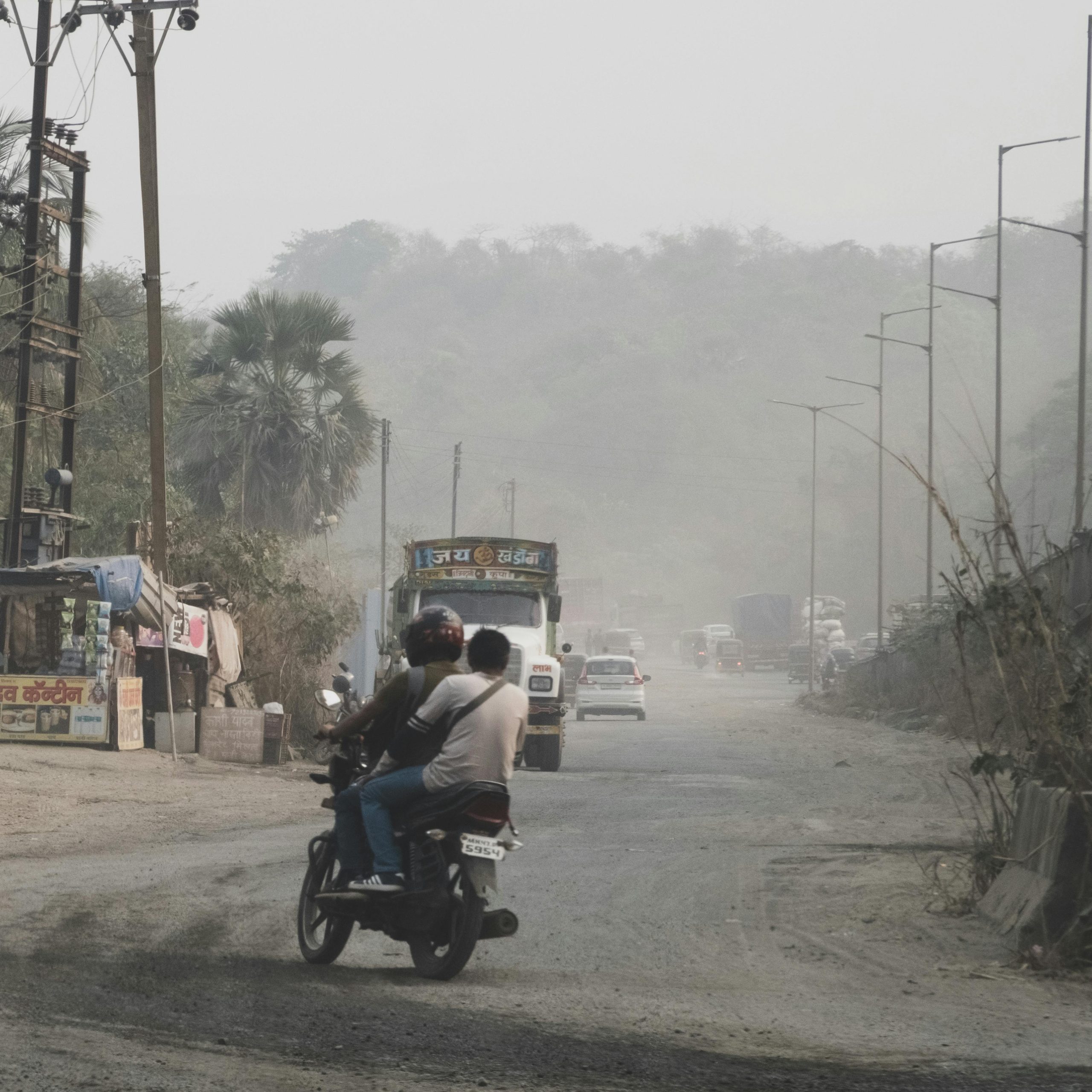
Environmental Governance and Policy
Air pollution
Microplastics: An Overlooked Contributor to India’s Air Pollution
28 January 2025
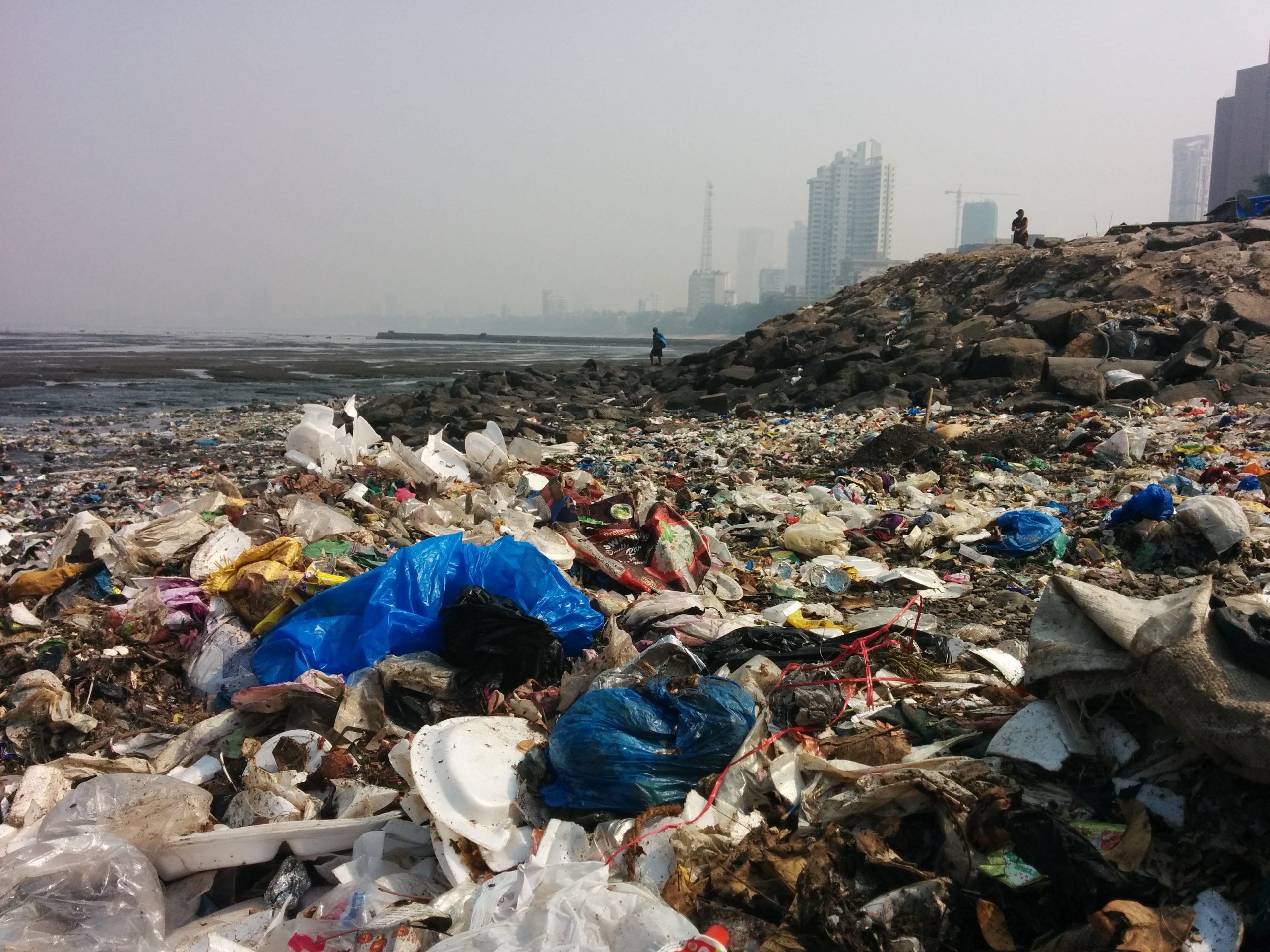
Plastic waste mounted on a landfill in Mumbai. Source: Flickr. CC BY-NC-SA 2.0 https://creativecommons.org/licenses/by-nc-sa/2.0/
On August 20, 2024, India’s National Green Tribunal (NGT) directed the Central Pollution Control Board (CPCB) to consider including microplastics – plastics with a diameter ranging from 1μm to 5mm – in the list of pollutants regulated under the National Ambient Air Quality Standards (NAAQS). These standards, last updated in 2009, set permissible limits on air pollutants harmful to human health, such as PM2.5 and PM10. However, microplastics are notably absent from this list of pollutants, despite growing research linking them to severe health risks, including damage to the nervous, circulatory, and immune systems, as well as cancer and reproductive disorders.
The exclusion of microplastics from NAAQS is just one example of the broader issue. India currently lacks a specific, comprehensive policy to address airborne microplastic pollution. Existing guidelines like the Solid Waste Management Rules 2024, and the Plastic Waste Management Rules 2024 also do not address the challenges posed by airborne microplastics. As a result, these pollutants remain largely unmonitored and unmanaged.
Compounding this issue is the limited research on airborne microplastics, stemming from the complexities involved in detecting and analysing these tiny particles in the atmosphere. Without adequate research and policy focus, the impacts of airborne microplastics on public health and the environment could continue to go unaddressed.
What then can India do to tackle this emerging pollutant, and how can we effectively mitigate its potential harm?
What are airborne microplastics, and how do they affect our health?
What are microplastics?
Plastics with a diameter ranging from 1μm to 5mm are called microplastics. They are of two types: primary microplastics, which are designed and manufactured for commercial use, such as microbeads in cosmetic and health care products or synthetic microfibers that shed from clothing; and secondary microplastics, which are created when larger plastics break down into smaller pieces due to weathering and degradation. Tyre wear also contributes to the release of microplastics into the environment, especially as part of non-exhaust pollution from traffic . Additionally, fast fashion, which relies on polyester, a material that is cheap, and readily available but is non-biodegradable, has also emerged as one of the largest contributors to microplastics from textiles.
How do microplastics become airborne?
While most studies have focused on microplastics in oceans and waterways, recent research indicates that microplastics can also become airborne, enabling rapid transboundary and long-range transport. This means that populations kilometers from the pollution source can be affected.
Microplastics become airborne through urban dust and soil, with their presence found in sedimented dust and fine atmospheric particles, as well as in airborne dust and both wet and dry deposition in urban and rural areas across the globe. Additionally, microplastics present on land or in water can easily become airborne, resulting in a cyclical exchange between land, water, and air. This creates the potential for a never-ending plastic cycle, making the removal of microplastics from the environment almost impossible.
Given their minuscule size, microplastics have been found “on mountaintops, in Antarctic ice cores, throughout our oceans, and in the bloodstream of human beings”.
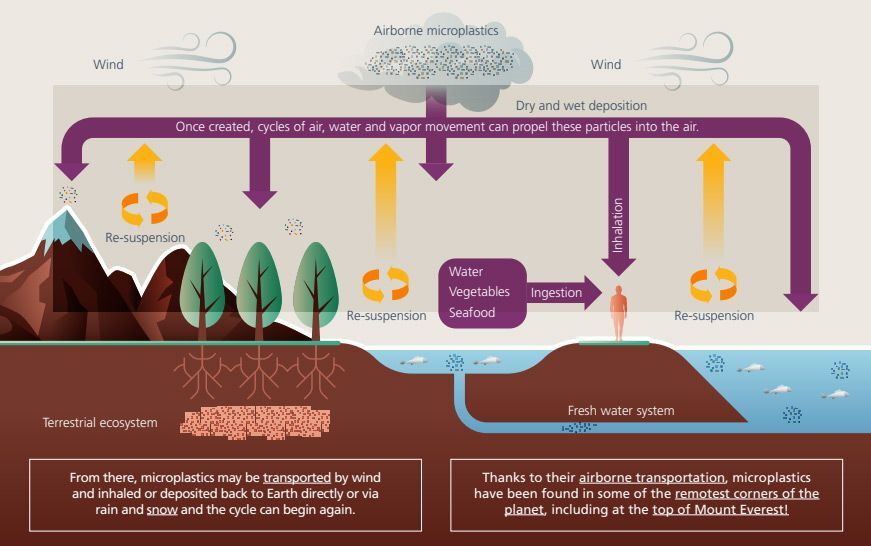
Health effects of airborne microplastics
Research shows that the small size of microplastics allows them to penetrate deep inside the human body, which induces respiratory issues and may even migrate to other organs. Humans are exposed to airborne microplastics through inhalation, ingestion, and potentially through skin contact. The impact of inhalation depends on size: some remain in the upper respiratory tract, while others can reach deep into the lungs. Their polymeric and sometimes fibrous structure makes them difficult to eliminate from the respiratory system. An average person can inhale up to 272 microplastic particles daily during light activities, with polyester fibers being a common source for clothing, furniture, and carpets.
Airborne microplastics pose an even greater threat to human health and the environment. Not only can they cause direct harm, but they also act as a trojan horse by carrying harmful chemicals and pathogens. As microplastics remain suspended in the air, they increase the risk of human exposure through inhalation of fine particles and inadvertent ingestion of contaminated geo-solids. This creates a complex and persistent threat to both human health and the environment, making their removal nearly impossible.
Moreover, microplastics serve as surfaces for microbial communities to thrive. This “plastisphere” of microorganisms, such as bacteria, enables them to survive in harsh environments and travel across ecosystems. Ingesting these microbes can lead to gastrointestinal infections, fever, and chills.
Why India needs to focus on microplastics
India faces a significant challenge with microplastics, primarily due to two interconnected issues – its position as the largest producer of plastic and its inability to effectively manage and recycle plastic waste.
1. A big plastic producer that imports waste: India is one of the most polluted countries in the world, with 42 out of the 50 most polluted cities in terms of air quality located within its borders. India is also the largest producer of plastic and plastic products, emitting about a fifth of all plastic waste generated in the world.
Despite its massive plastic production, India has been importing plastic waste from countries like China, Italy, Japan and Malawi, primarily to supply plastic processing units. This reliance on imports stems from India’s lack of adequate recycling infrastructure, starting with the first step of waste segregation. Imported plastic waste, already segregated, is easier and cheaper to process.
While a ban on plastic waste imports from these countries was imposed in 2019, the Ministry of Environment, Forest, and Climate Change partially lifted it in 2022, allowing the import of only PET bottles and flakes from countries like the US, Canada, and Germany. The reason cited for this allowance was the shortage of plastic waste in India, which was financially impacting processing units. The new policy allows the “import of PET flakes/bottles up to 50% of the production capacity of permitted firms”. Critics, however, have pointed out that it is not a shortage of PET waste, but rather the inadequate collection and segregation of plastic waste within India that leads to the ‘shortage’.
2. Inadequate plastic waste management: India’s capacity to manage plastic waste is alarmingly insufficient: of the 26,000 tonnes of plastic waste generated daily, only 8% of it is recycled. As of 2019, 23% of the waste generated ends up in landfills, 3% is incinerated and about 29% is mismanaged.
Plastics, when incinerated, can emit dioxins and other organic pollutants that lead to reduced visibility and worsened AQI. Poor recycling practices lead to increased air pollution as microplastics can become airborne through resuspension, further exacerbating health risks associated with pollution. This mismanagement of plastic waste thus contributes significantly to an ongoing air pollution and health crisis in the country.
Despite a 2022 ban on single-use plastics, enforcing the use of plastics thicker than 120 microns, this measure covers only about 10-15% of plastics in circulation. This highlights India’s challenge in effectively managing both the production and disposal of plastic.
NGT’s push for action on microplastics
August 2024 was not the first time the NGT asked the CPCB to look into microplastics as a possible risk factor for ill health and a contributor to the country’s poor air quality.
In 2021, the NGT took suo motu cognizance of possible microplastic pollution in the air, following the publication of a news article based on a research study conducted in Chennai that assesses the extent of microplastic pollution in the road dust of the city.
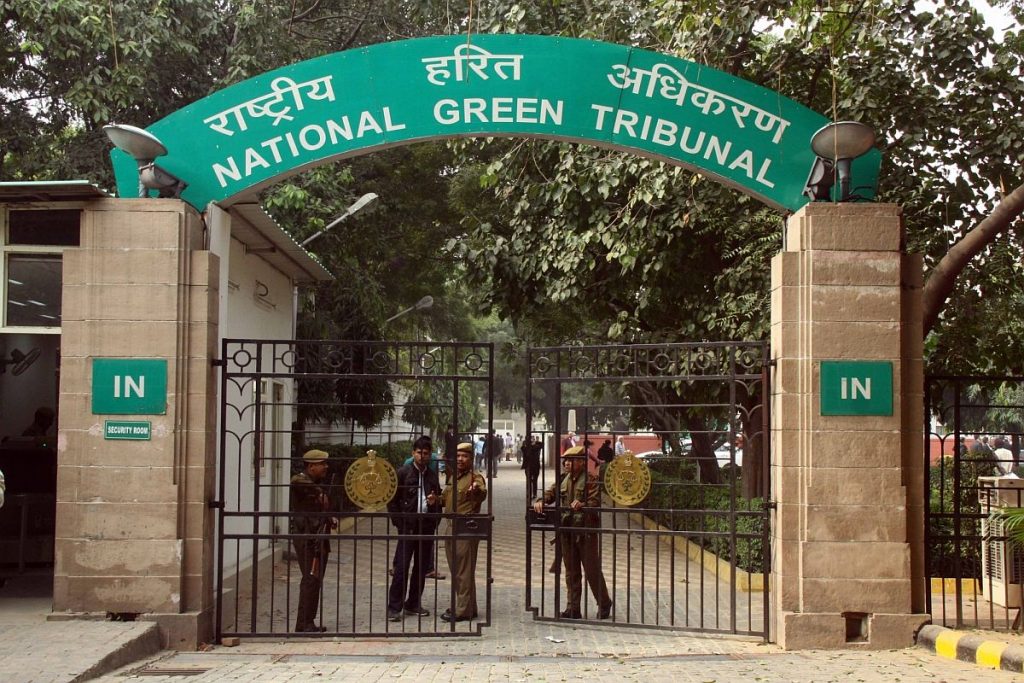
The NGT instructed the Tamil Nadu Pollution Control Board (TNPCB) to form an expert committee to assess the issue and provide recommendations. The committee confirmed the presence of microplastics in the air and groundwater around two Chennai landfill sites. It also emphasised the need for further evaluation by the National Environmental Engineering Research Institute (NEERI) to quantify environmental damage and restoration costs. (NGT OA 99/2021SZ). In a 2022 order, the NGT designated the CPCB as the nodal coordination agency to address and bridge this research gap.
In response, the CPCB, in 2023, acknowledged the existence of microplastics in the water and air and concluded that a standard method for sampling and analysis of microplastics in the environment is essential along with more research on the health effects of the pollutants.
Challenges to addressing airborne microplastic pollution in India
The recent Plastic Waste Management (Amendment) Rules, 2024 have introduced the term “biodegradable plastics”, defined as plastics that degrade biologically in soil or marine environments without leaving harmful residues, including microplastics. However, the amendments do not clarify how to identify microplastics or the necessary level of degradation required for a product to be considered biodegradable.
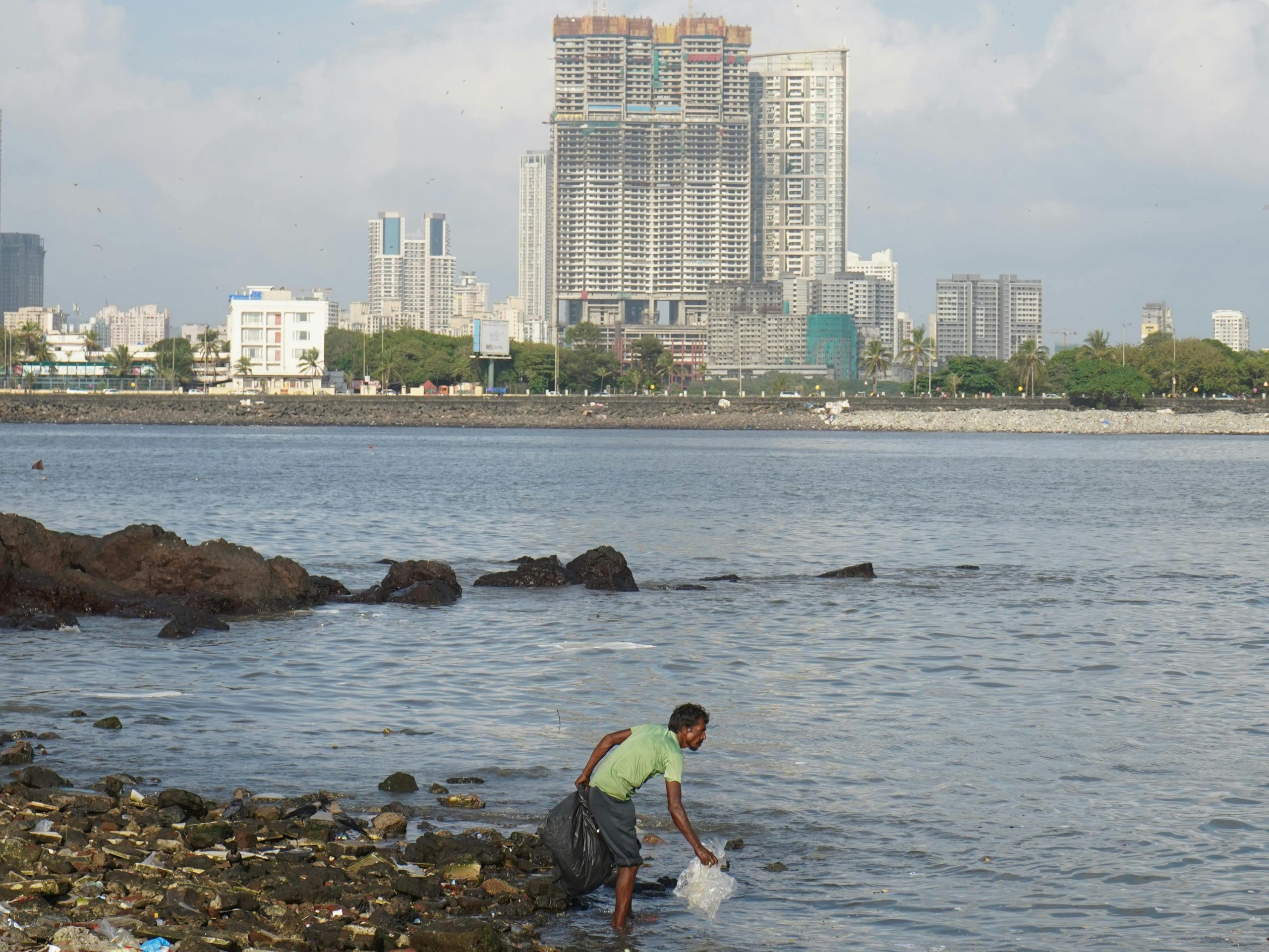
In 2023, the Bureau of India Standards stated that manufacturers claiming 100% biodegradable plastic may be “tantamount to misleading advertisement”, and advised the Ministry of Environment against certifying such claims. With the new rules however, challenges arise in certifying biodegradable plastics, as manufacturers often face difficulties obtaining provisional certificates from the Central Pollution Control Board (CPCB) due to unclear degradation criteria.
Another major challenge is the paucity of research in the sphere of microplastics. Research in airborne microplastics, in particular, is sparse due to challenges in detecting and analysing microplastics in the air. These challenges come from different factors: first, microplastics can come in many shapes, sizes, and types of plastic, which makes it hard to measure and identify them using regular testing methods. Second, other pollutants in the air can make it tough to find and analyse microplastics during sampling. Lastly, changes in the environment can affect their stability, and how microplastics behave in the air, making it even harder to detect and study them.
Possible solutions to manage and reduce airborne microplastics
As discussed in the above section, India faces numerous challenges in managing plastic waste and mitigating airborne microplastic pollution. Below are a few actionable solutions that target different aspects of the problem:
1. Building a robust research foundation: Along with a paucity of rigorous, collaborative research, there is also a lack of standardisation/unanimity of the concepts and units within the community. A comprehensive risk analysis of microplastics’ impact on human health is crucial to understanding the implications of this emerging pollutant.
With a robust research foundation, policymakers can establish clear standards and guidelines for microplastics. Understanding the lifecycle of these particles and developing effective removal and disposal strategies are essential. This collaborative effort will enable the creation of comprehensive regulations to effectively address the challenges posed by microplastic pollution.
2. Enhancing waste segregation at source: What should be done about the plastic that already exists, 3.46 million tonnes of which ends up in landfills or as marine litter? A crucial first step is the need to segregate waste at source (which includes households). Currently, only 30% of waste is properly sorted, causing valuable materials like plastics and metals to end up in landfills.
The Solid Waste Management Rules of 2016 mandate ‘waste generators’ to segregate and store organic waste and recyclable waste separately before handing it over to waste pickers. However, poor compliance undermines recycling efforts, as mixed waste reduces the quality and quantity of recyclables. Effective segregation ensures that plastic products can be effectively processed and recycled, reducing the amount of plastic waste that ends up in landfills. This is crucial because landfill leachate – the liquid formed when water seeps through a landfill – can contain harmful substances, including organic matter, heavy metals, and chemicals that threaten the environment and human health. In landfills, larger plastics break down into microplastics, which can leach into groundwater or become airborne.
Landfills in India pose another problem: they are severely over-capacitated and burdened. The Bhalswa and Ghazipur landfills in Delhi, for example, have been operating beyond capacity since 2002, highlighting the urgent need for improved waste management. However, even the introduction of Waste-to-Energy plants, which are touted as a magic solution to the country’s waste problems, may not prove to be as effective if proper segregation of waste at source is not ensured. Mixed waste has a low calorific value and high moisture content which can emit toxic substances when burned, thus contributing to local air pollution.
3. Raising public awareness and empowering stakeholders: Increasing public awareness of waste segregation and recycling is essential for better outcomes, as community participation fosters responsible disposal habits. To start, there is a need to create more awareness and education on the harmful effects of using single-use plastics of all types.
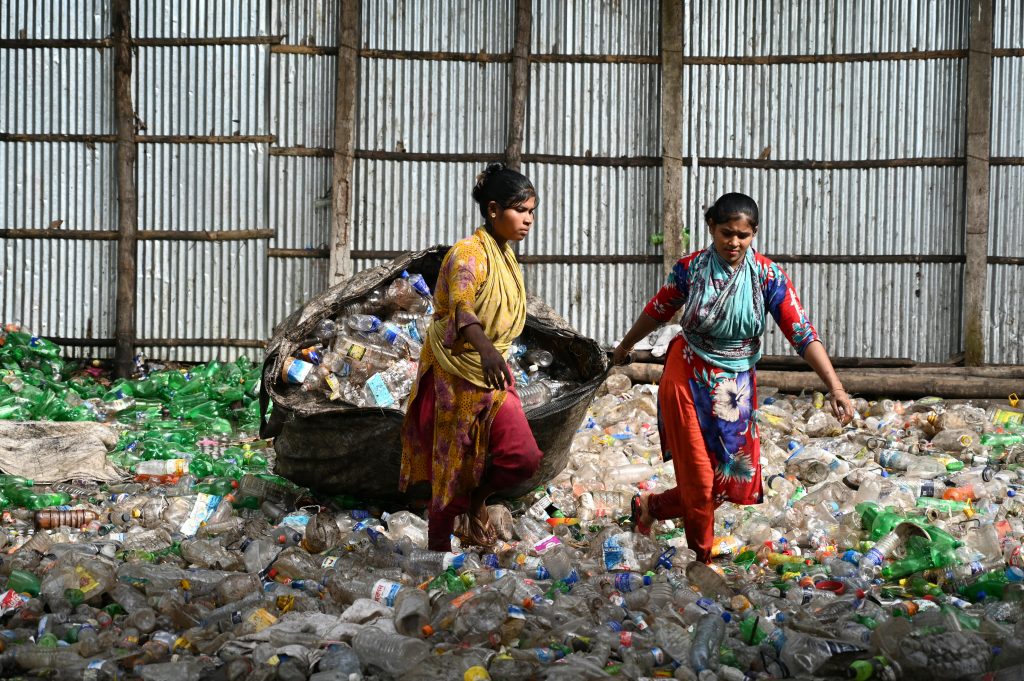
Empowering stakeholders can help enforce the practice of segregation, while also helping disseminate important solid waste management knowledge. The new Draft Solid Waste Management Rules, 2024, empower waste collectors to refuse to pick up unsegregated waste. They may also levy fines/penalties on unsegregated waste. The rules also provide a ‘polluter pays’ principle (environmental compensation/penalty levied on entities/persons failing to comply with the new rules). The Rules also expand the duties of Urban Local Bodies and state governments, especially concerning refuse-derived fuel plants which process non-recyclable waste into fuel for industrial use.
4. Incentivising recycling practices: Incentivising effective practices can further improve results. For example, Taiwan’s market-incentive recycling system charges producers recycling fees while subsidising local governments and businesses involved in waste collection. Similar programs that train rag-pickers and provide fair compensation can boost recycling rates.
There is an acute paucity of a well-functioning garbage collection infrastructure. Incentivising the supply chain can help induce good waste disposal habits and decrease the demand for landfills and other unregulated waste disposal areas.
Establishing decentralised waste processing units within cities can also improve municipal solid waste management. These units facilitate on-site segregation, composting, and biomethanation, reducing the burden on central landfills and limiting the plastic waste that may otherwise end up in landfills. There is a dire need to make current waste management systems more efficient and in tune with the waste generation and disposal realities of the world’s largest democracy.
Towards a circular plastic economy
Plastics are now so pervasive that the Earth may never be completely plastic-free. Human civilisation now exists in the “Plasticene” epoch. Concerted efforts to reduce plastic consumption and remove existing waste are the need of the hour, and a circular plastic economy is a crucial long-term solution. This approach focuses on reintroducing plastics into the manufacturing process for reuse rather than disposal, which requires a fundamental redesign of business models, materials, and packaging.
Additionally, the entire plastics supply chain needs remodelling and greening, with compostable, biodegradable plastics at the forefront. But are biodegradable plastics truly entirely biodegradable? This question has prompted large-scale research in conceiving a bioplastic that can completely decompose. Biodegradable plastics, such as PHAs (polyhydroxyalkanoates) and PLAs (polylactic acid), are essential for this shift. While PHAs are fully biodegradable, PLAs require industrial composting to degrade properly. However, these bioplastics can be expensive, and hence, are scarce in the market system, driving researchers to seek cost-effective solutions. It is also important to note that not much of research on biodegradable plastics is centred in the Indian context.
Government support is vital to build effective collection infrastructure and create self-sustaining funding mechanisms that foster a regulatory environment conducive to a circular plastic economy. The private sector – the producers, importers, and brand owners – that form part of the existing plastic supply chain also bears the burden of making small switches to reduce plastic use. This includes, in large part, plastic-free packaging of goods. This will help tackle the burden of existing plastics, help keep them in the supply chain, and reduce reliance on new plastics.
A circular plastic economy plays a critical role in addressing microplastic pollution. Redesigning products for longevity and recyclability significantly reduces the fragmentation of plastics into microplastics. Additionally, incorporating biodegradable alternatives can mitigate microplastic formation by ensuring that any residual materials break down more effectively rather than persisting in ecosystems.
Ultimately, addressing the presence and impacts of microplastics needs to be a collaborative effort involving private sector entities, government bodies, scientific communities, and civil society stakeholders.

